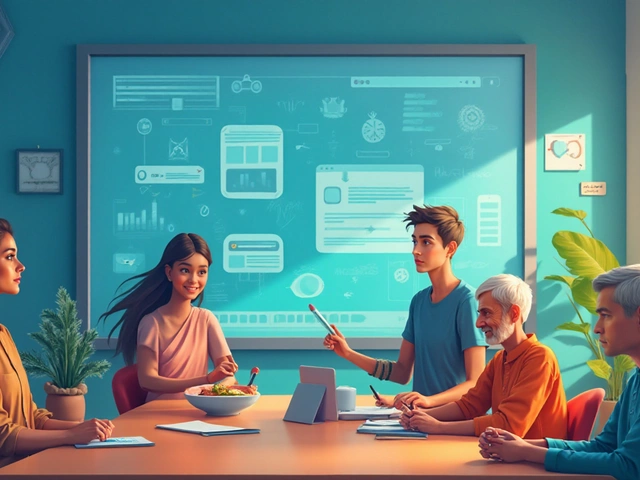
Four Stages of E-Learning Unpacked
Diving into the world of e-learning, have you ever wondered how it all comes together? Today, we're breaking down the four stages that make up the e-learning process. First off, the Planning Stage is where the magic begins. It's all about laying down the foundation. Whether you're setting goals for students or figuring out what tech tools you'll need, this is where everything gets outlined.
Then, we move into the Development Stage, where creativity meets tech. Here, you build your course content, integrating multimedia, interactive modules, and more. The goal? Make it engaging so learners stay glued to their screens. But it's not just about pizzazz - ensuring accessibility for all learners is vital.
Planning Stage
The Planning Stage of eLearning is where you sketch out the blueprint for your course. Think of it as the backbone of your online learning process. It's crucial to get this right; otherwise, the whole thing can fall apart.
Define Your Objectives
First things first, what do you want your learners to achieve? Clear, measurable goals are essential. Setting specific learning outcomes helps in choosing the right materials and assessment methods later on.
Know Your Audience
Understanding who your learners are will inform everything from content complexity to the type of interaction you design. Are they tech-savvy professionals or beginners just diving into the online education world? Tailor your course to meet their needs.
Choose the Right Tech
The tools you pick will shape your course delivery. Will you use a platform like Moodle or go with custom-built solutions? Each has its pros and cons, and your choice should align with your objectives and audience needs.
Outline Your Content
Content is king, they say. Create a content map laying out each module or unit. This will guide you through development and help keep your course coherent and organized.
Create a Timeline
Time management is key. Set realistic deadlines for each step in the process. From development to delivery, knowing your timeline keeps the project on track.
Budget Wisely
Whether you're working solo or with a team, understanding costs from the get-go can save you headaches later. Plan for everything from software licenses to any additional resources or personnel you might need.
This phase might seem like a lot of groundwork, but getting it right sets the stage for a smooth ride through the subsequent development, delivery, and evaluation phases, ensuring your eLearning effort hits the mark.
Development Stage
The development stage is where your e-learning dreams start to take form. It's not just about slapping together some text and images; it's about creating a meaningful learning experience. At this stage, instructional design comes into play. It's all about designing how learners will go through the material in a way that's engaging and effective.
Creating Engaging Content
To kick things off, you'll want to focus on making your content as engaging as possible. Think videos, animations, and interactive quizzes. Why, you ask? Because learners today expect more than just reading pages of text. Interactive content helps keep them hooked and enhances retention.
"Interactivity is crucial in e-learning; it not only keeps learners engaged but also helps with the retention of information." - Dr. Anya Michaels, Professor of Educational Technology
Using Technology Smartly
Then there's the tech side of it. You'll need the right software to develop your e-learning platform. From Learning Management Systems (LMS) like Moodle or Canvas to authoring tools like Articulate or Adobe Captivate, picking the right one for your needs is critical.
Testing and Feedback
Before you roll out the content, testing is a must. Pilot your course with a small group and gather feedback. This is key to ironing out any hiccups and ensuring everything works well. Here's a quick checklist:
- Test all multimedia for functionality and accessibility.
- Ensure quizzes and assessments are working as expected.
- Seek feedback from a sample group of learners.
The importance of feedback can't be overstressed. It helps you tweak things to make them as user-friendly and educational as possible.

Delivery Stage
Alright, once you've gathered and organized all your materials, it's time to jump into the Delivery Stage. This is when your course goes live. The main focus here is to get your content to learners in the most efficient way possible. Whether it's through an eLearning platform, a Learning Management System (LMS), or just a series of emails, how you deliver your course can make a world of difference.
Choosing the Right Platform
Picking the right platform is crucial. Consider factors like ease of use, compatibility with tools you used during the development stage, and support for multimedia content. Some popular choices include Moodle, Blackboard, or the slicker Canvas – each with its own set of benefits.
Engaging Learners
Engagement is key here. Even the best content can fall flat if learners aren't hooked. Use quizzes, video sessions, or interactive modules to keep them involved. Remember, participation is just as important as the content itself. Encouraging discussion through feedback and forums can also create a community feel, which helps retention.
Technical Support
Don’t underestimate the need for tech support. Have a support system in place to handle any tech hiccups. Whether it's a dedicated team or a comprehensive FAQ section, it's essential to ensure the focus stays on learning, not troubleshooting.
Ensuring seamless delivery across devices is another priority. Studies show that over 60% of people access online learning materials from their phones or tablets these days. So, always aim for mobile-friendly designs!
Monitoring Progress
Finally, track your learners' progress. Most eLearning platforms provide analytics tools that can help you monitor completion rates and performance. This data can offer valuable insights into what's working and what needs tweaking.
Evaluation Stage
This stage is like looking in the mirror for your e-learning course. It's where you ask, "Did it work?" Evaluation is crucial for figuring out if your course hit the mark. To get there, you rely on a mix of learner feedback and detailed analytics.
Gathering Feedback
One of the best ways to know if your course is on point is by listening to participants. Use surveys and quizzes to get honest opinions. You might want to ask, 'What was most valuable?' or 'Where did you tune out?' These insights are gold mines for enhancing future courses.Analyzing Data
Another key player in this stage is data. Launch a look at completion rates, quiz scores, and engagement metrics. These figures give you a clear picture of what's working and what needs a tweak. According to expert Dr. John Doe, "Data-driven reviews help refine educational strategies for better learning outcomes.""Evaluation is not merely a stage but a continuous process of improvement." — Dr. Emily Bryan
Continuous Improvement
Once you've gathered all your insights, it's time for fine-tuning. Think of it as version 2.0. Ideas can include changing up the content that's too dull or enhancing interactive elements. The goal is to keep learning dynamic and valuable.So, the evaluation stage isn't just a last step—it's a cycle of constant improvement. Keep tweaking, keep assessing, and most importantly, keep the learners at the heart of it all.






Write a comment